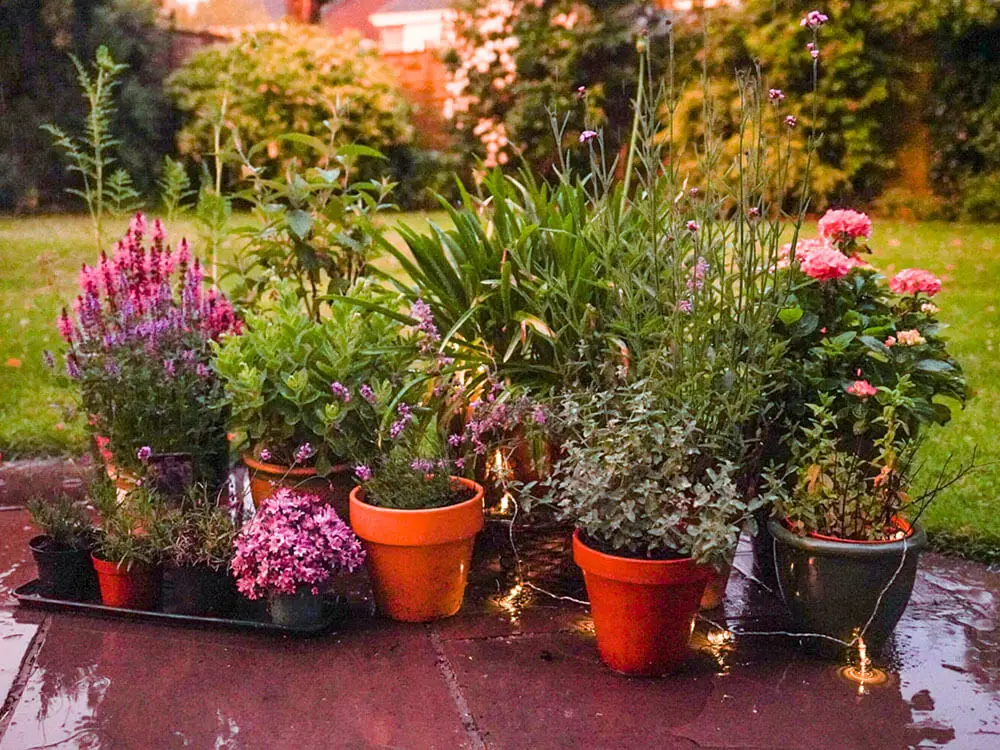How to Create a Cottage Garden with Containers
October, 2022 |The cottage garden is a timeless and hugely popular garden style design. So many people are naturally drawn to the soft textures and informal planting style.
The subtle foliage and pastel shades are in complete contrast to the large conspicuous leaves, lush greens, and bright colors of tropical plants.
We usually picture cottage gardens with large messy borders filled with a mass of flowers spilling out onto stone pathways, or flowers bobbing over the top of a stone wall or picket fence.
However, that rustic, cottage garden charm can easily be replicated with a collection of containers too. Even in the smallest of garden spaces, you can recreate the layers, colors, and charm that will turn balconies and courtyards into a scene from a Monet painting.
Disclaimer: This post contains affiliate links. When you make a purchase through one of these links I may earn a commission. This comes at no extra cost to you.
Which plants belong in a cottage garden?
You’ll find that most cottage garden plants are annuals (calendula), biennials (delphiniums), or small perennial shrubs (old roses). This small size makes them ideal for growing in a container cottage garden.
Some of the most traditional cottage garden flowers to include are hollyhocks, dianthus, and primulas. But cottage gardens traditionally contain more than just ornamental flowers, they’re usually home to herbs and vegetables too.

Fruit and Vegetables
Heirloom fruit and vegetable varieties are a popular choice in cottage gardens. Their long heritage and old-fashioned appeal match the rustic style of a cottage garden.
Some varieties you could include…
- Tomatoes: Gardeners delight, a delicious cherry tomato variety.
- Apples: Golden Pippin, a variety first recorded in 1629!
- Squash: Marina di Chioggia, an unusual squash variety from Italy.
If your garden space is limited, you can grow fruit trees in containers and choose columnar fruit trees or varieties that are grown on dwarf rootstock.
Kitchen and homeopathic Herbs
The cottage garden was originally a place to grow healing plants and herbs for the kitchen. Some traditional cottage garden herbs that once filled cottage gardens include:
- Sage
- Thyme
- Lavender
- Calendula

Choosing containers for your cottage garden
Containers and planters made from natural elements like stone, wood, clay, and terracotta will help to give your garden that rustic charm.
However, these containers can be expensive (and heavy!), so check out the sale sections in nurseries and garden shops. Websites like eBay, Gumtree, and Craig’s List are also great places to browse for secondhand planters.
Plastic planters with light, neutral colors, like green, beige, grey, or white also work really well. These outdoor plastic planters from Amazon come in a great range of colors and sizes that would work well for a cottage garden.
Size-wise, you could have one plant per container, or alternatively, you could have some large planters that contain plants in a mix of heights.
Need vertical supports for your cottage garden?
If you’re growing vertical vegetables like cordon tomatoes, beans, or peas, you’ll also need some vertical supports. Bamboo canes or long tree branches are commonly used in cottage gardens.
Other cottage garden plants that will need support include sweet peas and old climbing roses. Some taller plants like hollyhocks or delphiniums may need some support too.
Planting your cottage garden plants in your containers
The informal planting style of a cottage garden makes planting and arranging a breeze. You don’t need to follow color schemes, straight lines, or any ‘rules’.
Like the traditional French potager, cottage gardens contain a delightful mix of herbs, flowers, and shrubs, all mixed in together as one.
The only planting guidance is to check the maximum heights of your chosen plants and plant accordingly…
- Tall plants like vervain, hollyhocks, and foxgloves work well at the back of your arrangement, and old roses can be placed towards the back too.
- Medium-sized plants like lavender and salvias can fill out the middle of a container and provide a lush fullness to your cottage garden container.
- To recreate the effect of plants spilling out from their borders, choose low-growing flowers like campanula and phlox that can overhang the container and fill any gaps.
Potted cottage garden pruning and seasonal care
Its laidback planting style makes cottage gardens a really attractive design option. However, there are still a few jobs to check off each season, especially when planting annuals and keeping plants in containers.
Follow these seasonal tips to keep your cottage garden container plants looking healthy and producing plenty of flowers.
Spring
Spring and summer are both great months to start buying your cottage garden plants! You can grow lots of traditional flowers from seed really easily, like calendula. Or you can buy new plants from a nursery.
As new growth begins to emerge, you can cut back dead flower stems on plants like vervain, salvias, and hydrangeas from last year. Early spring is a great time to prune your container fruit trees too.
Summer
As your plants are in containers, it’s important to keep them well-watered, especially in dry periods.
Some cottage garden plants like salvias, campanula and will benefit from deadheading in late summer. This encourages the plant to produce a second flush of flowers that you can enjoy until the frosts hit in autumn!

Autumn
Now’s the time to collect any seeds from annuals or biennials that you’d like to grow for next year.
You can buy fresh plants in the spring, but growing them yourself is incredibly rewarding. Keep seed trays on windowsills or a mini greenhouse if your garden space is limited.
You could also move your containers into a more sheltered space in your garden, to protect the remaining plants from the wind and cold.
Remove finished annual plants like calendula, marigolds, or sweet peas. They can be added to a compost pile or balcony compost bin.
Related Read | 11 Autumn Garden Jobs for a Small Garden

Winter
Some plants, like salvias and vervain, will benefit from you leaving the dead flower heads and stems overwinter. They can provide valuable insulation through the winter months.
If you live in a really cold area, your perennial cottage garden plants may benefit from moving the plant to a garage, shed, or unheated basement.
If space is limited, covering the container with fleece can give the plants vital protection in heavy frosts and snowy weather.






